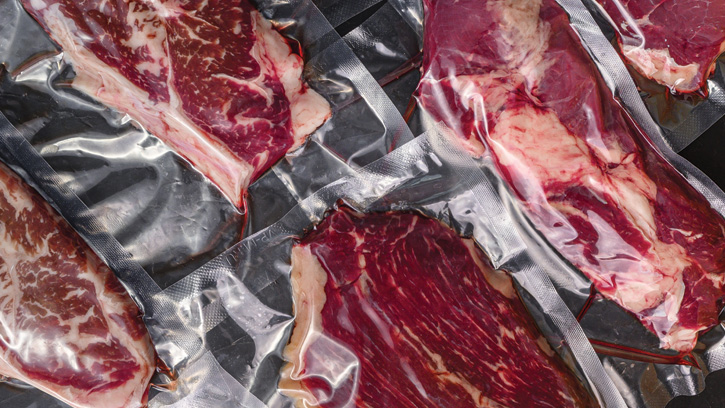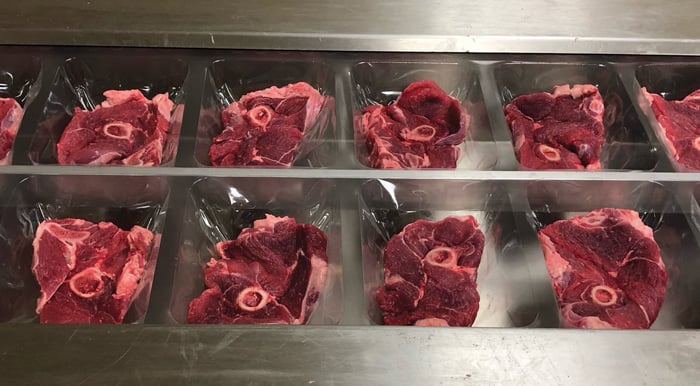Toward Smart(er) Fresh Meat Packaging
Packaging | APPLIED SCIENCE
The global meat packaging market, valued at $12 billion in 2020, is expected to reach nearly $14 billion by 2026, a compound annual growth rate (CAGR) of nearly 4.4%, according to marketing research firm Future Market Insights. Drivers for this multi- billion-dollar market include a sharp increase worldwide in the consumption and export of protein-rich products such as beef, pork, and poultry, as well as food processors’ demand for sustainable packaging that preserves food safety and quality attributes, maintains nutritional value, and extends product shelf life.
Certainly, fresh meat sold at retail remains popular with consumers because it can be readily cooked or frozen to extend the shelf life as needed. Packaged fresh meat and poultry is available in many formats, including overwrapped polystyrene trays, chubs, butcher paper wraps, pouches, and vacuum-packaged “brick” packs. No matter the format, however, today’s meat packaging must perform at an optimal level when it comes to food safety, quality, and shelf life to meet growing demand. Two developments of interest to fresh meat processors—real-time “dashboard” air temperature monitoring systems used to assure cold chain integrity of packaged goods and findings from meat research using vacuum packaging technology—are excellent examples showing how the industry is moving toward smart packaging solutions.
Tracking the Cold Chain
A tight cold chain is essential to maintain food safety and the quality of meat. The degree of processing and storage temperature determine product shelf life. For fresh meat, cold chain efficacy is tracked by measuring temperature, which is used to assess food safety and the consistency of meat products because the kinetics of degradative bacteria and oxidation accelerates as temperature rises. However, temperature is frequently seen as an indirect and lagging indicator of meat quality and safety. It is an indirect measurement because the actual microbial or oxidative reaction is not measured, and it lags because prior temperature records are used to estimate present meat safety and quality.
Meat quality has long been measured using sensors that detect microbial and oxidative reactions within the meat. These are applied directly to the primary package. However, these devices do not facilitate end-to-end (E2E) visibility throughout the meat supply chain. This is because sensors monitor meat directly and are hidden from view throughout the supply chain within primary or secondary packaging and later, within corrugated cases. This need for E2E visibility is an essential reason that air temperature in the cold chain is monitored.
For customers in the packaged meat supply chain, this form of E2E visibility by temperature monitoring demonstrates supply chain temperature compliance. For example, a pallet of ground beef could be unintentionally left on a loading dock on a balmy day and subsequently loaded onto a trailer. Because temperature monitoring of the pallet and the trailer were recorded and disseminated across the supply chain, the temperature abuse encountered would be known and cases of sliced ham on pallets then could be managed appropriately to ensure safety and quality. This quick action allows the product to be treated differently, such as being designated for a quick sale or quick donation, being upcycled into a food ingredient, or being designated as food waste. Monitoring temperature in the air surrounding meat or on a case or pallet is also practical since the temperature can be quickly and inexpensively measured, provides an indirect indicator of meat shelf life, and is a first step in determining if there is a problem with the meat that requires further investigation.
Developing indicators that help identify an issue before it is manifested is an area of much research, and air temperature monitoring makes possible predictive analytics and supply chain resilience. A link between the air around the pallet and the air within a tractor-trailer during transit to the actual product temperature while in transit is crucial for evaluating the actual shelf life of a product. For example, if the monitored air temperature within a refrigerated tractor-trailer containing pallets of vacuum-packaged sliced ham within a corrugated case reaches 40°F three times during a 6 hr transit due to the door being opened and closed when deliveries are made, the ham would be assessed to determine if it is still safe. This assessment could include microbial testing. In this scenario, a correlation between the temperatures within the case of sliced ham and the trailer air temperature is employed to assess whether the sliced ham is still below the acceptable temperature.
Food companies that transport perishable products like fresh meat and poultry continue to seek out advanced product and packaging monitoring systems and other science-based strategies to maintain cold chain integrity. Erik Anderson, director of food safety with Sysco, says that monitoring the temperature of refrigerated packaged foods in transit is necessary to ensure food quality and safety, as well as to reduce shrinkage and food waste, which is why the multinational foodservice distributor has invested in advanced monitoring technologies over the years.
“In the 1990s, Sysco was an early adopter of temperature monitoring using strip chart recorders,” Anderson says. “Since the 2000s, we have implemented digital time-temperature recorders and real-time ‘dashboard’ reporting, and we are piloting an enhanced inbound shipment HACCP monitoring process employing temperature correlations between the air within a tractor-trailer and a particular product. This facilitates improved decision making on alarmed shipments where quality or safety may be impacted.”
Equipped for Research
Another area of interest is vacuum-packaged meat, which is used to preserve high-value retail-ready consumer meat products requiring an extended shelf life, primarily due to its ability to prevent freezer burn and regulate oxygen migration. Critically, vacuum packaging isolates red meat in an anaerobic environment, prolongs its shelf life, and diminishes the availability of heme iron in myoglobin to bind with oxygen, resulting in a darker surface color. However, North American consumers of red meat products do not prefer a darker surface color. Thus, some oxygen migration is permitted through red meat packaging to preserve the oxymyoglobin pigment preferred by consumers. During freezing, myoglobin denatured by lipid oxidation can cause color variations in fresh beef. Oxygen scavengers have been used to regulate oxygen exposure and limit lipid oxidation.
The Auburn University Lambert-Powell Meats Laboratory, which has served as a training facility for livestock scientists for nearly 20 years, has been using the technology to explore meat and packaging interactions. Since August 2020, packaging research at the lab has become more robust due to the addition of a vacuum thermoform horizontal-form-fill-seal machine donated by packaging equipment supplier Winpak. The equipment enables vacuum packaging of meat processed at the Auburn facility into thermoformed vacuum-packaged containers and supports research advancing meat packaging science.
Without this machine, products would have to be shipped for vacuum packaging, significantly altering the meat’s properties, notes Jason Sawyer, associate professor of meat science at Auburn’s Department of Animal Sciences. “Thanks to Winpak’s investment in our laboratory, our students and industry partners have been able to assess packaging variables more quickly and improve meat shelf life,” Sawyer says.
Recent research using the machine revealed that the color of meat packaged in poor barrier films was more acceptable than that of superior barrier films (Wagoner et al. 2002). In addition to polyethylene, films with a barrier contained polypropylene and polyethylene. Other new research from this alliance connects the dots between customer preferences for meat color and the oxygen transfer rates required for vacuum-packaged meat. Intriguingly, research indicates that water loss during freeze-thaw cycles causes shifts in fat and protein concentrations and alterations in surface chemical concentrations, which alter the surface coloration that consumers observe.
Many retailers are requiring flexible film to be compatible with store-drop-off recycling. However, shelf life is a concern since the barrier of recyclable film is higher (i.e., worse) than the more common package of a tray overwrapped in PVC.
Recent research on sustainable packaging for ground beef shows consumers connect sustainability with packaging that is recyclable and includes both paper and plastic (AURI News 2021). Consumers also connected sustainability with packaging that prevents their wasting of meat. They made this connection when shown resealable packaging, packaging that allows for no-mess portioning of meat, and intelligent packaging that communicates the number of days left to safely consume the ground beef. Follow-up research funded by the Beef Checkoff that explores the sustainability connection between packaging options that prevent consumer meat waste is underway. Tristan Reyes, an Auburn graduate and now technical services and application specialist with Winpak, used the Auburn facility to produce commercial prototype samples for this research.
Meat, the Future
Whether it’s improved food safety and quality through more effective cold chain monitoring or technological advances in preserving meat quality attributes and extending shelf life of fresh meats, moving toward more integrated packaging solutions is the way of the future.
Learning Objectives
- Understand the role of temperature monitoring of the cold chain in meat safety and quality.
- Learn the impact of vacuum packaging different barrier variables on meat shelf life.
- Appreciate how value chain partners, suppliers, and universities can work together to achieve shared value.




